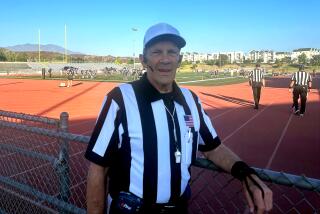Diocesan Files Show Deceit, Denial
The local Catholic hierarchy never passed itself off as divine.
Good thing.
The disclosures this week from the Diocese of Orange put names and faces to two decades of cover-ups and left one indelible impression: The hierarchy was all too human.
As human as any corporate executive trying to save his skin in an accounting scandal. As human as any cop or military man protecting a fellow officer from charges of excessive force. As human as any gang member refusing to rat out the shooter in a drive-by.
In street terms, it’s called the code of silence.
I don’t know what they called it in the diocese.
I know all too well that many readers have had it up to here with stories about priests or other diocesan officials or educators who molested or otherwise sexually abused young people. Those readers, who have made their displeasure known to me and others at the newspaper, argue that the point has been made and that it’s time to move on.
These stories won’t run forever, but the release this week of 10,000 pages of documents -- keep in mind they were from only one diocese -- underscore that we probably didn’t have a full grasp of just how deep the cover-ups were during the period preceding the administration of the current bishop, Tod D. Brown.
For example, it’s one thing to say, “OK, we know some church officials didn’t handle things well” and quite another to quote from the church’s files. Notes from Times reporter William Lobdell reflect this entry from an unnamed church official in July 1985 about a priest, Father Al Ramos: “a.m. phone call from Al -- wanted to report that he had ‘slipped’ and had an incident with a 17-year-old boy from parish.”
Two days later, the official noted: “9 a.m. Met with Al. Al said parent not going legal ...”
Two months later, local church officials transferred Father Ramos, whose indiscretions with boys dated to at least 1979 -- according to church files -- to Tijuana.
Had something like that been a one-time incident it could be forgiven. Or, at least, put in a different perspective.
However, the files and court cases show the opposite. In one, a 1992 case involving another Orange County priest accused of molesting a young parishioner, a high-ranking church official -- Michael P. Driscoll, now Bishop of Boise, Idaho -- recommended that the priest be sent to England. The court records indicate Driscoll noted that the priest “is in jeopardy of arrest and possible imprisonment.”
That’s how mob capos handled their subordinates when they knew or sensed they were too “hot” to hang around town. It’s how they maintained power and defended their empires.
I’ve never heard of any law-abiding citizen who told us to quit writing about corporate scandals or criminal cover-ups.
Readers who think I enjoy gouging the Catholic Church are mistaken. I’m not the least bit cynical about the way that good priests minister to the flock, and I take no pleasure in quoting the church about its own conspiracies of silence.
But these are misdeeds that left a mark. They damaged lives and created increased distrust of the church. Current diocesan officials like Tod Brown, whether forced into action by lawsuits or not, realize that the church’s credibility is at stake.
With the diocese’s own files as gospel, it’s clear that Brown’s predecessors thought the road to credibility was paved with deceit and denial.
Oh, so human a motive. But doomed.
Brown knows that the Catholic Church’s message -- delivered by priests in homilies or private counseling -- has saved innumerable lives over the years.
That must be consoling to him.
But Brown also seems to grasp what some other diocesan leaders around the country haven’t: that parishioners can forgive the occasional priest for his wrongs but not the church leadership for covering them up.
Dana Parsons’ column appears Wednesdays, Fridays and Sundays. He can be
reached at (714) 966-7821 or at dana.parsons@latimes.com. An archive of his recent columns is at www.latimes.com/parsons.
More to Read
Sign up for Essential California
The most important California stories and recommendations in your inbox every morning.
You may occasionally receive promotional content from the Los Angeles Times.










